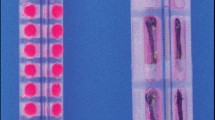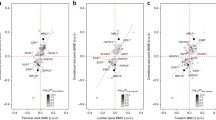Abstract
Map-based cloning is an iterative approach that identifies the underlying genetic cause of a mutant phenotype. However, the classic protocol of positional cloning is time-consuming and labor-intensive. We now describe a genome sequence–based cloning approach that has led to localizing the underlying genetic cause of spontaneous fractures (sfx) in a mouse model. The sfx/sfx mouse is characterized by a spontaneous femoral fracture seen around 6 weeks of age, which represents a new mouse model for bone fragility. Genetic studies indicate that the phenotype of sfx/sfx mice is caused by an alteration at a single locus that is roughly mapped onto the central region of mouse Chromosome 14. Using our strategy of combining mouse genome resources and high-throughput technology, we discovered a deletion of all 12 exons in the gene for L-gulonolactone oxidase (LGO), a key enzyme in the synthesis of ascorbic acid. We have also examined the expression of LGO and found no expression of LGO in sfx mice while the LGO expresses in several tissues of normal mice. Our data demonstrated the feasibility to positionally clone the mutated gene from a non-fine-mapped locus, which has applicability to the positional cloning of genes from many other animal models, as their genome sequences are sequenced or will be sequenced soon.





Similar content being viewed by others
References
WG Beamer CJ Rosen RT Bronson W-K Gu LR Donahue et al. (2000) ArticleTitleSpontaneous fracture (sfx): a mouse genetic model of defective peripubertal bone formation Bone 27 IssueID5 619–626 Occurrence Handle10.1016/S8756-3282(00)00369-0
MB Brooks W Gu JL Barnas J Ray K Ray (2003) ArticleTitleA line 1 insertion in the factor IX gene segregates with mild hemophilia B in dogs Mamm Genome 14 788–795 Occurrence Handle10.1007/s00335-003-2290-z
G Ellender T Gazelakis (1996) ArticleTitleGrowth and bone remodeling in a scorbutic rat model Aust Dent J 41 IssueID2 97–106
W Gu GM Acland AA Langston et al. (1998) ArticleTitleIdentification of a RAPD marker linked to progressive rod-cone degeneration in dogs Mamm Genom 9 740–744 Occurrence Handle10.1007/s003359900855
W Gu M Brooks J Catalfamo J Ray K Ray (1999a) ArticleTitleTwo distinct mutations cause severe hemophilia B in two unrelated canine pedigrees Thromb Haemost 82 1270–1275
W Gu K Ray S Pearce–Kelling VJ Baldwin AA, et al. Langston (1999b) ArticleTitleEvaluation of apolipoprotein H (APOH) gene as a positional candidate gene for progressive rod–cone degeneration (prcd) disease Invest Ophthalmol Vis Sci 40 1229–1237
WJ Gu XM Li B Edderkaoui DD Strong KH Lau et al. (2002a) ArticleTitleConstrution of a BAC contig for a 3 cM biologically significant region of mouse chromosome 1 Genetica 114 IssueID1 1–9 Occurrence Handle10.1023/A:1014609809681
W Gu X Li KH Lau B Edderkaoui LR Donahae et al. (2002b) ArticleTitleGene expression between a congenic strain that contains a quantitative trait locus of high bone density from CAST/EiJ and its wild-type strain C57BL/6 J Funct Integr Genomics 1 IssueID6 375–386 Occurrence Handle10.1007/s10142-001-0042-2
W Gu XM Li BA Roe KH Lau B Edderkaoui et al. (2003) ArticleTitleApplication of genomic resources and gene expression profiles to identify genes that regulate bone density Curr Genomics 4 75–102
C Guerriero D Santis ParticleDe PF Nocini P Gotte U Armato (1995) ArticleTitleTissue culture of adult human osteoblasts isolated from jaw bones Ital J Anat Embryol 100 Suppl 1 83–93
L Hasan P Vogeli S Neuenschwander P Stoll E Meijerink et al. (1999) ArticleTitleThe L-gulono-gamma-lactone oxidase gene (GULO) which is a candidate for vitamin C deficiency in pigs maps to chromosome 14 Anim Genet 30 IssueID4 309–312 Occurrence Handle10.1046/j.1365-2052.1999.00481.x
R Horai S Saijo H Tanioka S Nakae K Sudo et al. (2000) ArticleTitleDevelopment of chronic inflammatory arthropathy resembling rheumatoid arthritis in interleukin receptor antagonist-deficient J Exp Med 191 IssueID2 313–320 Occurrence Handle10.1084/jem.191.2.313 Occurrence Handle1:CAS:528:DC%2BD3cXntFemsw%3D%3D Occurrence Handle10637275
F Horio K Hayashi T Mishima K Takemori I Oshima et al. (2001) ArticleTitleA newly established strain of spontaneously hypertensive rat with a defect of ascorbic acid biosynthesis Life Sci 69 IssueID16 1879–1890 Occurrence Handle10.1016/S0024-3205(01)01261-9
T Kawai M Nishikimi T Ozawa K Yagi (1992) ArticleTitleA missense mutation of L-gulono-gamma-lactone oxidase causes the inability of scurvy-prone osteogenic disorder rats to synthesize L-ascorbic acid J Biol Chem 267 21973–21976
K Kawai H Ito H Kubota K Takemori S Makino et al. (2003) ArticleTitleChanges in catecholamine metabolism by ascorbic acid deficiency in spontaneously hypertensive rats unable to synthesize ascorbic acid Life Sci 72 IssueID15 1717–1732 Occurrence Handle10.1016/S0024-3205(02)02481-5
DE Kipp M McElvain DB Kimmel MP Akhter RG Robinson et al. (1996) ArticleTitleScurvy results in decreased collagen synthesis and bone density in the guinea pig animal model Bone 18 IssueID3 281–288 Occurrence Handle10.1016/8756-3282(95)00481-5
X Li W Gu G Masinde S Xu D Mohan et al. (2001) ArticleTitleGenetic control of the rate of wound healing in mice Heredity 86 668–674
X Li GJ Masinde W Gu J Wergedal M Hamilton–Ulland et al. (2002) ArticleTitleChromosomal regions harboring genes for the work to femur failure; in mice Funct Integr Genomics 1 IssueID6 367–374 Occurrence Handle10.1007/s10142-001-0045-z
N Maeda H Hagihara Y Nakata S Killer J Wilder et al. (2000) ArticleTitleAortic wall damage in mice unable to synthesize ascorbic acid Proc Natl Acad Sci USA 97 IssueID2 841–846 Occurrence Handle10.1073/pnas.97.2.841
Y Nakata N Maeda (2002) ArticleTitleVulnerable atherosclerotic plaque morphology in apolipoprotein E–deficient mice unable to make ascorbic acid Circulation 105 IssueID12 1485–1490 Occurrence Handle10.1161/01.CIR.0000012142.69612.25
M Nishikimi T Kawai K Yagi (1992) ArticleTitleGuinea pigs possess a highly mutated gene for L-gulono-gamma-lactone oxidase, the key enzyme for L-ascorbic acid biosynthesis missing in this species J Biol Chem 267 21967–21972
Y Sakamoto Y Takano (2002) ArticleTitleMorphological influence of ascorbic acid deficiency on endochondral ossification in osteogenic disorder Shionogi rat Anat Reg 268 IssueID2 93–104 Occurrence Handle10.1002/ar.10122
S Sotiriou S Gispert J Cheng Y Wang A Chen et al. (2002) ArticleTitleAscorbic-acid transporter Slc23al is essential for vitamin C transport into the brain and for perinatal survival Nat Med 8 514–517 Occurrence Handle10.1038/nm0502-514 Occurrence Handle1:CAS:528:DC%2BD38Xjt1Kgur0%3D Occurrence Handle11984597
Y Tong Y Dumont SH Shen R Quirion (1997) ArticleTitleComparative developmental profile of the neuropeptide YY1 receptor gene and protein in the rat brain Mol Brain Res 48 323–332 Occurrence Handle10.1016/S0169-328X(97)00107-1
A Tumber MC Meikle PA Hill (2000) ArticleTitleAutocrine signals promote osteoblast survival in culture J Endocrinol 167 IssueID3 383–390 Occurrence Handle10.1677/joe.0.1670383
RH Waterston et al. (2002) ArticleTitle(Mouse Genome Sequencing Consortium) Initial sequencing and comparative analysis of the mouse genome Nature 420 520–562 Occurrence Handle10.1038/nature01262 Occurrence Handle12466850
I Wegger B Palludan (1994) ArticleTitleVitamin C deficiency causes hematological and skeletal abnormalities during fetal development in swine J Nutr 124 IssueID2 241–248
Acknowledgments
Funding for WKG came from the Center of Excellence for Genomic and Bioinformatics, Center of Excellence for Diseases of Connective Tissues at the University of Tennessee Health Science Center, and the Veterans Administration Medical Center, Memphis, TN; and from NIH (AR51190). Funding for WGB was from NIH AR43618 and CA43619 (CORE grant, The Jackson Laboratory). Funding for YT and DG came from NIH 5U01MH61971. We thank Dr. Vicki Park for providing human DNA samples and information on polymorphism. We thank Dr. Syamal K. Bhattacharya for measuring of mineral contents of the bones.
Author information
Authors and Affiliations
Corresponding author
Rights and permissions
About this article
Cite this article
Jiao, Y., Li, X., Beamer, W.G. et al. A deletion causing spontaneous fracture identified from a candidate region of mouse Chromosome 14. Mamm Genome 16, 20–31 (2005). https://doi.org/10.1007/s00335-004-2414-0
Received:
Accepted:
Issue Date:
DOI: https://doi.org/10.1007/s00335-004-2414-0




